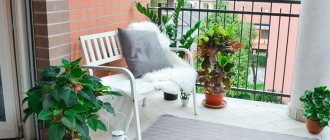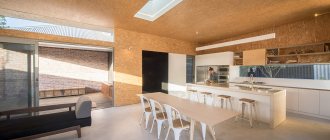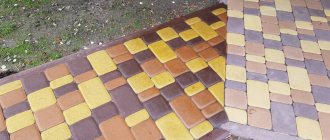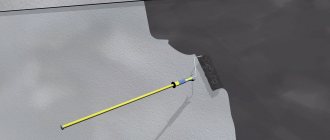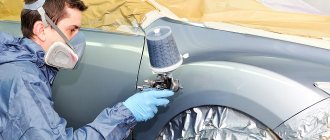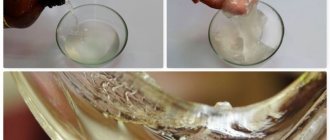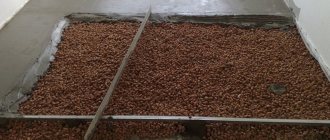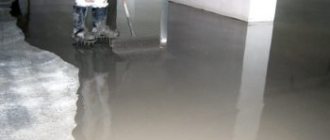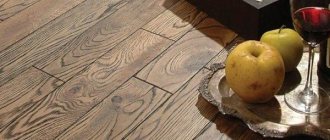The basis of any epoxy floor is a two-phase composition of epoxy resin and its hardener. Also, the composition of the components of this type of coating can be supplemented with various additives that stabilize the mixture and increase the strength of the coating to mechanical damage (latex, casein), as well as substances that promote the fluidity of the solution. Before pouring the floor, pigments are added to the mixture. This is done to give it the desired shade.
To give the mixture the desired shade, special additives are added to it.
Sometimes, for a decorative effect, the composition is supplemented with diamond or other mineral chips, but such mixtures are very difficult to polish after hardening. This circumstance will create certain difficulties if you decide to make an epoxy floor with your own hands.
Sometimes the mixtures are supplemented with diamond chips
Distinctive advantages and disadvantages
The optimal combination of components that make up an epoxy self-leveling floor gives it a number of special positive properties.
- High resistance to wear: such a surface will last for decades and will retain its presentable appearance for a long time.
- Easy to maintain: thanks to the monolithic structure of the floor, its surface is less susceptible to the accumulation of dirt and, as a result, the proliferation of colonies of harmful microorganisms on its surface. A flat and smooth surface is easier to wet clean and requires minimal consumption of cleaning agents and disinfectants.
- Resistance to temperature changes: Epoxy liquid floors can withstand various temperature fluctuations. Therefore, they can be used even in baths. Such a coating can withstand winter in an unheated room and maintain its presentation and performance characteristics.
- Chemical resistance: the surface can withstand exposure to even highly concentrated acids and alkalis.
- Good waterproofing properties: this type of flooring does not require additional waterproofing in the room, since it is endowed with almost zero vapor permeability and copes with this task independently.
- Wide prospects for design solutions.
Such floors are very resistant and durable.
All the above-described advantages of epoxy self-leveling floors allow them to be used in premises for a wide variety of purposes, be it industrial workshops, chemical laboratories, industrial warehouses or public institutions (kindergartens, educational organizations, clinics, shopping centers, etc. ). Nowadays such floors are increasingly found in private houses and apartments.
Such floors have become more common in private houses and apartments
With all the wide range of advantages, epoxy self-leveling flooring is not without its disadvantages that should be taken into account.
- High labor intensity of preparatory work and high final cost of work and materials costs.
- Marking of the material: chips and scratches that appear during everyday use are clearly visible on the floor surface. When the need for repairs comes, it is almost impossible to choose the color of the composition that matches the damaged coating.
- Removing old coatings can be a difficult process that takes a lot of effort and time.
In addition to all the advantages, such floors also have disadvantages.
Composition and advantages of epoxy coating
Epoxy polymer floors, unlike polyurethane ones, are based on the following two main components:
- epoxy resin;
- special hardener.
They also contain various stabilizers, and to increase aesthetics they use various color schemes and decorative elements, say, glitter.
Advantages
- Coating integrity. There are no joints or seams on the floor surface, which prevents moisture and dust from penetrating under the covering and dirt from accumulating in the seams. The foundation is not afraid of destruction or deformation.
- Easy to use. This type of flooring is low maintenance. You can wash it without any problems, thanks to its sufficient resistance to all sorts of aggressive influences, for example, moisture, household chemicals, abrasives, etc.
- Safety. The coating is not only fireproof and non-slip and, despite popular belief, after complete hardening it does not pose a danger to human health.
It’s worth making a reservation here: in the liquid state, the mixture contains substances that really irritate the mucous membranes and can cause burns and slight suffocation. However, due to the negligible percentage of content, volatile substances have time to evaporate during the polymerization of the base. That is why the use of protective equipment - protective clothing, glasses and gloves when pouring self-leveling floors is mandatory.
- Resistance to temperature changes and extreme temperatures.
- Wear resistance and increased strength characteristics. The self-leveling floor is resistant to mechanical and physical stress and ultraviolet radiation, chemical neutrality.
- Tightness of the base. Having filled all the pores and irregularities, the liquid composition provides the base with solidity and tightness.
- Wide design possibilities that allow you to choose a coating option that harmoniously fits into any interior.
- Hygiene. On such a surface there are no favorable conditions for the formation and spread of various harmful microorganisms: mold, mildew and others.
Epoxy self-leveling flooring, of course, has a lot of advantages, however, we must not forget about its significant drawback - it is poured monolithically over the entire surface, so there can be no question of replacing or repairing a separate section. Let us also add that dismantling such a floor requires a significant investment of time, labor and finances.
- Among the disadvantages of epoxy coating, it is also necessary to note the insufficient strength to point loads, that is, if a heavy object is hit or dropped, cracks or chips can be expected. Such phenomena can be avoided if the composition used corresponds to the characteristics of the room being finished. For example, the classic composition is used for rooms with low traffic, and for arranging floors that experience high loads, quartz fillers are needed.
- Such floors have a long service life - about 20 years. No matter how wear-resistant they are, scratches or other minor defects may form on the surface during this period. In this case, it will be necessary to update the coating, say, apply another layer of the polymer composition.
Tips for choosing a self-leveling epoxy floor and calculating consumption
Depending on the purpose of the room prepared for installation of a self-leveling epoxy floor, a mixture with suitable characteristics is selected. Materials are classified according to the thickness of the applied coating.
It is advisable to use coatings for applying a thick layer if it is necessary to level a base with a large difference in height. Depending on the manufacturer’s recommendations, the thickness can range from 80 to 100 mm. The material consumption in this case is very high. Such mixtures are not intended for pouring a thin layer.
Compositions for forming a thin layer are used exclusively for finishing floor pouring. The thickness can even start from 1 mm. The consumption of materials will accordingly be the least.
Depending on the manufacturer’s recommendations, the thickness can range from 80 to 100 mm
Prices for mixtures for thin-layer epoxy self-leveling floors are an order of magnitude higher than those for thick layers. However, given that the consumption of such a mixture is very low, the final price becomes quite acceptable.
You can calculate the cost of covering a room by multiplying the product of the height and area of the coating by the density of the solution. For example, for 1 m² of floor with a thickness of 1 mm, one liter of mixture will be required. Multiplying the volume by the density of the composition 1.3 kg/l, we get 1.3 kg of finished mass. Some manufacturers, in order to reduce the cost of mixtures for self-leveling floors, introduce heavy additives into their composition, such as barite or quartz and river sand, as a result the density of the mixture increases to 1.65-1.75 kg/l. Consumption will increase accordingly. As a result, at the same price per kilogram, material consumption will increase by almost 30%!
Mixture consumption may vary depending on the purpose
Coating features
The basis of the mixture for self-leveling floors is an epoxy resin and a hardener, and they are often called two-component mixtures.
If you mix these two components, you can get a very hard surface that is not afraid of mechanical stress and will serve for many years. Also often additional components are added to the mixture, for example, latex or casein, which make the floors even more durable and resistant to damage. Sometimes sodium nitrite is added so that the floors can withstand sudden temperature changes, which is important for industrial buildings.
At the very beginning of their invention, such floors were used only for industrial facilities and public buildings. But over time, self-leveling floors began to be used in the design of apartments and houses. Indeed, in addition to their durability, epoxy floors are famous for the fact that you can add any color or decorative elements to the floor mixture, place any picture under a transparent base and other methods, which leads to unlimited design possibilities for these floors.
Other advantages of such floors are:
- smooth surface with gloss, the degree of which can be influenced using additional components;
- durable coating and high abrasion resistance;
- long service life, more than twenty years;
- safety, no release of harmful substances was detected when using these floors;
- seamless coating makes cleaning and maintaining the floor easier, prevents the accumulation of moisture and the growth of bacteria and dirt;
- water resistance, the floor does not absorb moisture and does not allow it to pass anywhere;
- repels dirt well;
- resistance to aggressive chemicals;
- the resin contained in the floors does not support combustion;
- almost complete absence of odor, which is slightly felt when the mixture is kneaded, but it is easy to dissipate;
- the ability to regulate the degree of roughness so that the floor is not slippery even if oil is spilled on it.
But along with the advantages, epoxy floors also have disadvantages:
difficulty in dismantling in case of errors in filling or changing the floor covering to another;- high costs of materials and pouring work;
- loss of decorativeness of the coating after a certain period of time, scratches and tarnishing of gloss;
- the fragility of the floors, if it is hit hard with a heavy object, cracks and chips may appear;
- the need to carefully prepare the base of the floor so that the difference is no more than 1 millimeter per 100 centimeters;
- labor-intensive process of installing floors;
- It is better not to use epoxy floors for underfloor heating; when heated, they begin to emit an unpleasant odor.
Having studied all the recommendations for making an epoxy floor and strictly following the technology, you can install such a floor without the help of specialists.
Required tools and materials
To achieve the best possible result, you will need the following list of tools and special protective equipment:
- Grinder;
- vacuum cleaner;
- container for mixing the solution;
- drill with screw attachment;
- high pile roller;
- squeegee;
- needle roller;
- gloves;
- paint shoes;
- respirator;
- putty knife.
Needle roller for self-leveling floor
Materials that will be needed at all stages of work:
- seam sealant;
- primer;
- potting mixture;
- polyurethane varnish;
- polymer composition.
Before starting work, you should prepare thoroughly
Epoxy self-leveling floor - pouring technology
The ready-made epoxy compositions that exist today allow you to fill the floor with your own hands, without having any special skills in this matter or special expensive tools.
Before you begin the process of installing an epoxy floor, you will have to take time to prepare the room in which the work will be carried out. The main requirements for the surface on which the future floor will be applied will be its strict horizontal orientation and minimal humidity. The permissible slope in the horizontal plane is 2 mm per two meters of surface length. Maximum surface humidity is 4%. This requirement is due to the close to zero vapor permeability of epoxy resin.
Now there are mixtures that do not require special preparation skills
Excess moisture from the base will quickly begin to destroy the base layer. If the mixture will be applied in place of the previous coating, traces of paint, grease stains and other contaminants should be removed, then all chips, seams and cracks should be repaired. The seams are primed and filled with sealant. The base can be secured by applying epoxy paint to it.
Before you start priming the floor, you need to remove any dust that has settled on it using a vacuum cleaner. After this, you can begin applying the primer layer. If the surface texture is rough, then two coats will be sufficient, but if the surface is smooth, 3-4 coats should be applied. Each successive layer is applied only on top of the completely dried previous one. Priming helps to increase the adhesion of the base to the material applied to it.
Before starting work, you should remove all debris with a vacuum cleaner.
You can start pouring the base layer when the top layer of primer is completely dry. The mixture with an epoxy resin base is applied in wide stripes. To evenly roll out the initial layer, it is better to use a squeegee. It is more convenient to work in the corners of the room with a spatula. To avoid leaving marks on an already filled surface, you should wear paint shoes. Once the solution has completely filled the floor area, it is important to roll the entire surface with a needle roller to remove air bubbles.
It is important to know that in the prepared solution the polymerization processes will take effect within 30 minutes, so you should prepare and apply the epoxy mixture in portions so that it does not have time to harden before pouring and leveling. Work is carried out at a temperature not lower than 10C. There should be no drafts or sudden changes in temperature in the room until the solution completely hardens.
It takes 2 days for the floor to dry completely.
Epoxy floors dry in about 7 hours, but are fully cured in about two days. Only after complete polymerization can you proceed to pouring the finishing layer.
Before applying the final layer of self-leveling epoxy flooring, a decorative coating is applied to the base layer. It could just be a layer of decorating chips. The most original options would be surface painting with acrylic paints or a banner network with any digital image. Modern three-dimensional printing of the image you like will add special chic to the flooring.
Floors painted or digitally patterned will look very nice.
After pouring the finishing layer, wait until the surface has completely hardened and secure the result with a layer of polyurethane varnish. After the varnish has dried, which will happen in two days, you can use the room for its intended purpose.
If you strictly follow the pouring technology and sequence of work, epoxy floors will serve you for decades. No other type of flooring offers such durability coupled with aesthetic appeal.
